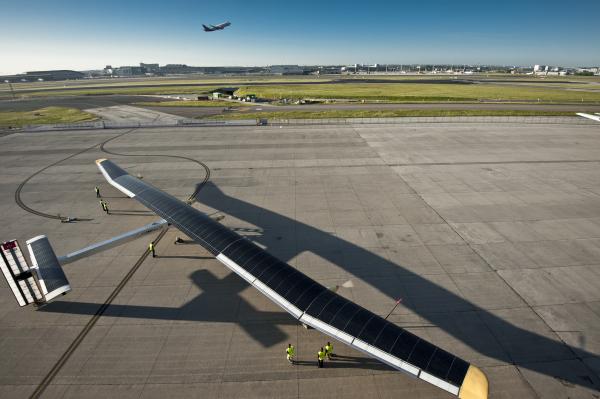The Solar Impulse team has already set the record for the world’s longest fully solar-powered flight, and now it plans to take its four-engine plane that weighs less than an SUV around the world powered by nothing but the sun.

(Solar Impulse aircraft)
The Solar Impulse aircraft is powered by the 12,000 solar cells that rest below the solar panels on the upper part of the wings. The cells capture the energy of the sun and transform it into electricity, simultaneously powering the four engines and lithium ion batteries. While the airplane is in flight, it is powered by the energy of the sun, storing excess energy in the batteries, which can than be used at night or whenever sunlight is unavailable.
When Solar Impulse founder and chairman Bertrand Piccard first embarked on building the plane nine years ago, he said no one believed he would be able to fly a solar-powered aircraft around the world. But with the help of fellow Swiss pilot and engineer Andre Borschberg, they were able to complete a 26-hour solar powered flight over Switzerland in 2010. Now the duo plans for a flight from California to New York City in 2013, followed by 20-day flight around the globe in 2015.
“All of the control system for the entire propulsion of the airplane, the energy collection, is driven by a computer which we developed in house, because no technology like this exists on the market,” said Borschberg. “What we specially developed is our own satellite communication systems, because what was available was much too heavy.”
Swisscom helped to develop the lightweight communication system used by the pilot in the cockpit, which the Solar Impulse team said allows communication between the aircraft and virtually any mission control unit. The cockpit also features avionics that indicate flight path and lateral drift developed by watchmaker OMEGA, which also provided the LED landing lights that illuminate the wings, which span over 206 feet.
“In an airplane that is so big, the bank is an issue,” said Piccard. “We are limited by for normal operations to 5 degrees and to never exceed bank at 10 degrees. So when you compare it to a normal airplane — which normal bank is 25 degrees in a turn — you see how sensitive the instrument must be.”
OMEGA’s instrument provides a vibration in the sleeve of the pilot jacket whenever the aircraft exceeds 5 degrees.

(Solar Impulse flying over Switzerland)
The Solar Impulse team is ready to embark on its preliminary cross country flight in 2013 and its flight around the globe in 2015. The only challenges they face now are minor, according to Piccard, as the aircraft’s extremely light weight makes it susceptible to storms and the plane stalls at lower speeds. The team estimates the aircraft will take five days to fly across the Pacific Ocean on its circumnavigation route, which could cause it to run out of the solar power stored in its batteries.
While Piccard does not foresee commercial airlines looking to carry passengers on solar powered commercial flights any time soon, he does believe the concept and technology can be mimicked and used to reduce aircraft emissions in the future.
“It would be crazy to answer yes, and stupid to answer no,” said Piccard, when asked about the possibility of commercial availability of the Solar Impulse aircraft technology. “Just now we don’t see how it would be possible to transport 200 people or a huge payload without fuel as we are doing on our airplane. But we have seen how fast the history of aviation has gone, maybe there will be an evolution of technology that will allow it.”